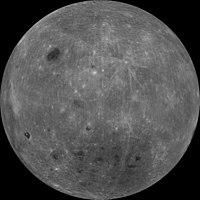South Pole–Aitken basin

The South Pole-Aitken basin is an impact crater on Earth's Moon. Roughly 2500 kilometers in diameter and 13 kilometers deep, it is the largest known impact crater in the entire Solar System. The only impact basin close to it in size is the 2100 kilometer Hellas Planitia on Mars. This basin was named for two features on opposing sides; the crater Aitken on the northern end and the southern lunar pole at the other end. The outer rim of this basin can be seen from Earth as a huge chain of mountains located on the lunar southern limb, sometimes called "Leibnitz mountains", although this name has not been considered official by the International Astronomical Union.
Discovery
The existence of a giant far side basin was suspected as early as 1962 based on early probe images (namely Luna 3 and Zond 3), but it was not until the acquisition of global photography by the Lunar Orbiter program in the mid-1960s that geologists recognized its true size. Laser altimeter data obtained during the Apollo 15 and 16 missions showed that the northern portion of this basin was very deep,[1] but since these data were only available along the near-equatorial ground tracks of the orbiting Command and Service Modules, the topography of the rest of the basin remained unknown. The first complete geologic map showing the confines of this basin was published in 1978 by the United States Geological Survey.[2] Little was known about the basin until the 1990s, when the spacecraft Galileo and Clementine visited the Moon. Multispectral images obtained from these missions showed that this basin contains more FeO and TiO2 than typical lunar highlands, and hence has a darker appearance. The topography of the basin was mapped in its entirety for the first time using altimeter data and the analysis of stereo image pairs taken during the Clementine mission. Most recently, the composition of this basin has been further constrained by the analysis of data obtained from a gamma-ray spectrometer that was onboard the Lunar Prospector mission.
Physical characteristics

The lowest elevations of the Moon (about -6 km) are located within the South Pole-Aitken basin, and the highest elevations (about +8 km) are found on this basin's north-eastern rim. Because of this basin's great size, the crust at this locale is expected to be thinner than typical as a result of the large amount of material that would have been excavated during this impact event. Crustal thickness maps constructed using the Moon's topography and gravity field imply a thickness of about 15 km beneath the floor of this basin, in comparison to the global average of about 50 km.[3]
The composition of this basin, as estimated from the Galileo, Clementine and Lunar Prospector missions, show that it is different than typical highland regions. Most importantly, none of the samples obtained from the American Apollo and Russian Luna missions, nor the handful of identified lunar meteorites, have a composition that is comparable. The orbital data indicate that the floor of this basin has slightly elevated abundances of iron, titanium, and thorium. In terms of mineralogy, the basin floor is much richer in clinopyroxene and orthopyroxene than the surrounding highlands that are largely anorthositic.[4] Several possibilities exist for this distinctive chemical signature. One is that this composition might simply represent lower crustal materials that are somewhat more rich in iron, titanium and thorium than the upper crust. Another possibility is that this composition reflects the widespread distribution of ponds of iron-rich basalts, similar to those that make up the lunar maria. Alternatively, the rocks here could contain a component from the lunar mantle if the basin excavated all the way through the crust. The origin of the anomalous composition of this basin is not known with certainty at this time, however, and a sample return mission will most likely be required to settle this debate. Complicating matters is the fact that all three of the above hypotheses could contribute to the anomalous geochemical signature of this giant crater. Furthermore, it is possible that a large portion of the lunar surface in the vicinity of this basin was melted during the impact event, and differentiation of this impact melt sheet could have given rise to additional geochemical anomalies.
Origin
Simulations of near vertical impacts show that this basin should have dug up vast amounts of mantle materials from depths as great as 200 km below the surface. However, observations thus far do not favor a mantle composition for this basin, and crustal thickness maps seem to indicate the presence of about 10 kilometers of crustal materials beneath this basin's floor. This has suggested to some that the basin was not formed by a typical high-velocity impact, but may instead have been formed by a low-velocity projectile that hit at a low angle (about 30 degrees or less), and hence did not dig very deeply into the Moon. Putative evidence for this comes from the high elevations north-east of the rim of the South Pole-Aitken basin that might represent ejecta from such an oblique impact.
References
Cited references
- ^ W. M. Kaula, G. Schubert, R. E. Lingenfelter, W. L. Sjogren, W. R. Wollenhaupt (1974). "Apollo laser altimetry and inferences as to lunar structure". Proc. Lunar Planet. Sci. Conf. 5: 3049–3058.
{{cite journal}}: CS1 maint: multiple names: authors list (link) - ^ D. E. Stuart-Alexander (1978). "Geologic map of the central far side of the Moon". U.S. Geological Survey. I-1047.
- ^ Mark Wieczorek and 15 coauthors (2006). "The constitution and structure of the lunar interior". Reviews in Mineralogy and Geochemistry. 60: 221–364. doi:10.2138/rmg.2006.60.3.
{{cite journal}}: CS1 maint: numeric names: authors list (link) - ^ P. Lucey and 12 coauthors (2006). "Understanding the lunar surface and space-Moon interactions". Reviews in Mineralogy and Geochemistry. 60: 83–219. doi:10.2138/rmg.2006.60.2.
{{cite journal}}: CS1 maint: numeric names: authors list (link)
General references
- G. Jeffrey Taylor (1998). "The biggest hole in the Solar System". Planetary Science Research Discoveries.

